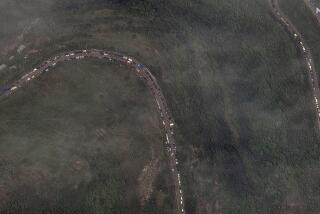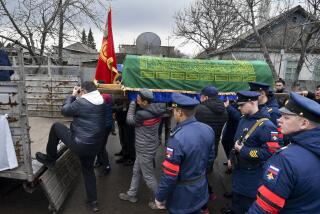Regional Outlook : Central Asia’s ‘Test-Tube Baby’ : The Western world has spent $160 million to wean Kyrgyzstan away from its Communist-era economy. Results are mixed, at best.
- Share via
BISHKEK, Kyrgyzstan — Bleak and grandiose Soviet-era government buildings still dominate the icy center of this capital city, a mute, powerful warning to all who would try to break the grip of these temples of bureaucracy on the small Central Asian state of Kyrgyzstan.
But it is precisely here that the International Monetary Fund, with the blessing of the United States, has tried to set up a free-market showcase for the 50 million people in the five newly independent states that once constituted Soviet Central Asia.
“Kyrgyzstan is a test-tube baby, but it had better be healthy. If hope of economic prosperity dies, war starts,” said Metin Goker, the Turkish ambassador, a rare foreign envoy to what even in Soviet times was a small, remote republic of 5 million.
So far, the Kyrgyz seem to have an abundance of hope. In a referendum Sunday, more than 96% of its citizens voted in support of their president, 49-year-old Askar Akayev. The president’s spokesman said Monday that voters had demanded “a sharp radicalization of reforms, and they will follow.”
Though Kyrgyzstan is certifiably reform-minded, if its performance is the best that Central Asia can do in practice, the mostly Muslim, mostly Turkic-speaking peoples of the wide steppes and high mountains between Russia and China had better tighten their belts for a long, hard haul to free-market prosperity.
All five republics have used their own methods to keep new ideas at bay as Moscow has cut subsidies and transfers, culminating in the collapse of the so-called “ruble zone” three months ago.
Uzbekistan and Tajikistan have kept the lid on with repressive, unreformed governments. Turkmenistan has used natural gas revenues to buy off its population with free water, electricity and soon bread. Relatively liberal Kazakhstan has also benefited from huge oil and mineral wealth.
But even the two regional giants, Uzbekistan and Kazakhstan, were forced to announce the progressive merging of their economies this month in an attempt to survive. Small Kyrgyzstan has said it will join them, and its experience may be a salutary lesson in the obstacles that lie in Central Asia’s path.
Superficially, the Kyrgyz seemed to have a lot going for them: a genial and progressive president, Akayev; a smiling and open people; and one of the better human rights records in the former Soviet Union. But past habits have proved hard to break, and the country has become something of a test of Western moral and financial fiber.
“Every quarter the IMF comes. Unfortunately, we are not good pupils,” said Kyrgyz National Bank Director Kemalbek Nanayev, speaking with the disarming frankness of his people. “Privatization is slow. We have to support ineffective sectors. . . . We try to adopt IMF suggestions, but not all.”
Akayev, a convinced reformer, has no regrets about following IMF advice to launch the first currency in the region, the som. “Time showed we were right. . . . We prevented an economic disaster. We are just a small country and we could have been carried away in the storm of ruble inflation.”
But once Russia cut off aid, the IMF had to step into the breach. So far, it has spent more than $60 million supporting the Kyrgyz currency, and the United States added a grant of more than $100 million. The bill is likely to go on mounting. Landlocked Kyrgyzstan was almost completely dependent on the Soviet system: 10% of its gross domestic product was transferred as straight gifts from Moscow, and much of its industry collapsed along with the Soviet Union. One day, Kyrgyzstan may produce 20 tons a year of gold, export farm products and perhaps hydroelectricity. But the country is so hard-pressed that a local prospectus currently lists such odd-sounding exports as frozen pancreases, nomad felt tents, antimony waste, hens’ dung and the droppings of silver mice.
Some Kyrgyz have started to cross the bridge to a free-market system, as elsewhere in Central Asia. They trade from kiosks on street corners or from blankets on the icy pavement, the economic cocoons from which free-market butterflies may one day emerge.
But everywhere, the old Soviet-era bureaucrats have proved as unwilling as elsewhere in Central Asia to stand aside and abandon the practices of a lifetime. Many officials hold that the common people are childlike and need to be guided.
For instance, there is still no law allowing a firm to go bankrupt, however much money it loses. Kyrgyz collective farms had a surplus of wool and tobacco last year. But it still languishes in warehouses because the bureaucracy has not given export licenses. Would-be private restaurants have been closed down. As elsewhere in the former Soviet Union, anything private is automatically perceived by many as “the mafia.”
“It’s the old Soviet mentality that cannot see that private good can lead to public good,” one Western diplomat said. Kyrgyz Deputy Foreign Minister Askar Aitmatov put it another way, saying the government “would not permit the country to be ransacked.”
The question is, who is doing the ransacking? The Kyrgyz National Bank has auctioned off more than $50 million of its IMF dollars, but few of them have been easily available to private enterprises. On the streets, few doubt that those close to the bureaucrats have benefited.
Monetary controls vital to maintaining the value of the new Kyrgyz som are under constant attack. Ministers and top bureaucrats believe that by providing long lines of credit to otherwise useless state factories they can avoid social unrest and jump-start the economy. The state enterprises’ budget is ballooning with soft credit.
As a result, inflation is ticking back up toward 40% a month. The Kyrgyz som has halved in value against the dollar since May and a further steep fall seems inevitable.
With the economy going back to basics, farms will be vital. Peasants are getting relatively rich on earnings from private plots, including the increasing cultivation of cannabis and poppies. But the moment anybody tried to sell to all comers, officials slapped on export tariffs. The “state orders” that defined centralized Soviet economic activity may have changed their name, but a plan to cut such compulsory production and purchases by 50% on Kyrgyz state and collective farms failed, said the acting minister of agriculture, Boris Talgarbekov. “Under the guise of the national interest, the majority of administrators are going to pursue the old, dead-end agricultural policy, which will bury the rural reforms,” he wrote in a local newspaper.
Managers were therefore unwilling to take free-market steps like investigating which crops are in demand. Worst of all is the paradox that the public blames the collapse in its standard of living not on the bureaucrats but on the reforms. As Talgarbekov warned: “People are coming to hate the nonexistent market . . . a nostalgia for the command economy and the Communist regime has appeared.”
More to Read
Sign up for Essential California
The most important California stories and recommendations in your inbox every morning.
You may occasionally receive promotional content from the Los Angeles Times.













